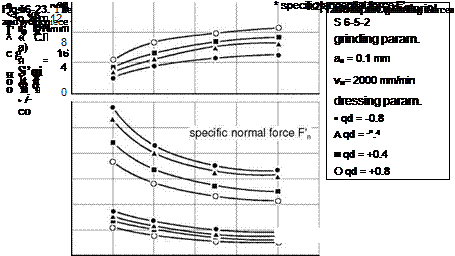Increasing the dressing feed frd during roller dressing leads, analogously to external cylindrical plunge grinding, to a higher dressing material removal rate. Because of this, the resultant grinding wheel effective surface roughness and dressing forces increase.
In Fig. 6-23, the influence of dressing feed on the grinding forces as well as on workpiece roughness is shown for a process with continuous dressing. By varying the dressing speed ratio qd in down and up dressing, we also show its varying influence on the dressing output and thus on the grinding process. Up dressing the grinding wheel leads to high grinding forces, but also to improved surface qualities on the workpiece. Workpiece roughness improves with increasing ratios of dressing speeds in up dressing. The reason for this is that the grinding wheel layer is dressed with a lower effective surface roughness with increasing relative speed between the dressing roller and the grinding wheel.
Due to enlarged grinding wheel effective surface roughness, increasing the dressing feed leads to lower cutting forces, from which results a reduction of the required grinding effort. Therefore, a grinding wheel dressed with a higher dressing feed at otherwise constant grinding conditions leads to lower grinding process temperatures, which reduces the risk of thermal damage to the workpiece surface. Workpiece roughness gets worse however with increasing dressing feed, so that an

additional smoothing process has to follow the roughing process when the requirements on surface quality are high.
dressing feed fr<
In the case of continuous dressing, an increase in dressing feed with otherwise constant variables has a negative effect on the cost efficiency of the machining process, since grinding wheel consumption increases at equal machining times. However, with a grinding wheel with a larger effective surface roughness, due to the thus realisable lower cutting forces and temperatures, the machining performance can be enhanced without damaging the workpiece surface to an unallowable extent.
